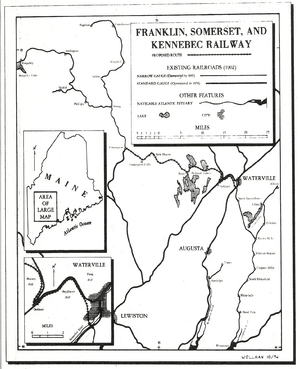Wiscasset, Waterville and Farmington Railway facts for kids
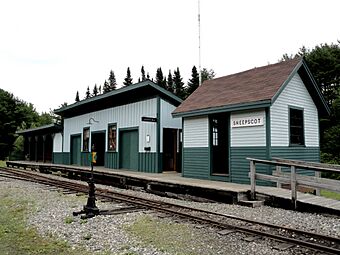
The WW&FR depot on July 20, 2014
|
|
| Overview | |
|---|---|
| Headquarters | Wiscasset, Maine |
| Reporting mark | WW&FR |
| Locale | Alna, Maine |
| Dates of operation | 1895–1933 1989–present |
| Technical | |
| Track gauge | 2 ft (610 mm) |
| Length | 3.2 miles (5.1 km) |
| Other | |
| Website | http://www.wwfry.org |
The Wiscasset, Waterville and Farmington Railway (WW&FR) is a special kind of train line. It uses a narrow gauge track, which means the rails are closer together than on regular train tracks. This railway first ran as a business from 1895 until 1933. It connected towns in Maine like Wiscasset, Albion, and Winslow.
After being shut down in 1936, a part of the track in Alna has been rebuilt. Today, about 3.5 miles (5.6 km) of the line is run by a non-profit group called the Wiscasset, Waterville and Farmington Railway Museum. This museum operates the line as a heritage railroad. This means it offers fun passenger train rides and sometimes carries cargo, letting people experience what trains were like long ago!
Contents
The Railway's Story
The railway started running on February 20, 1895. Back then, it was called the Wiscasset and Quebec Railroad. Its goal was to reach Quebec, Canada, but it never quite made it!
In 1901, the railway changed its name to the Wiscasset, Waterville and Farmington Railway. It built a branch line to Winslow by the Kennebec River. However, it couldn't connect with another narrow gauge line in Farmington. This meant the dream of reaching Quebec didn't come true.
What the Trains Carried
The WW&F trains carried many different things. They moved farm products like potatoes, lumber from forests, and poultry (chickens and other birds). They also carried general freight and passengers. In 1914, a lot of what they carried was lumber (43%) and potatoes or canned corn (16%). They also brought in things like animal feed, grain, manufactured goods, and coal.
Challenges and Closure
By the late 1920s, the railway started having problems. More and more people were using roads and cars, which meant fewer people and goods traveled by train. A businessman named Frank Winter bought the railway. He hoped to use the trains to move coal and lumber between Wiscasset and other towns.
However, on June 15, 1933, a train accident caused operations to stop. Frank Winter's plans never fully happened, and he passed away in 1936. Most of the railway tracks and equipment were taken apart and sold for scrap.
The WW&F Railway Museum Today
Luckily, the story didn't end there! In 1989, a non-profit group started the WW&F Railway Museum. This museum has worked hard to bring the railway back to life. As of 2025, they have rebuilt about 3.5 miles (5.6 km) of the old track in Alna.
The museum now runs historic steam and diesel trains, along with other old railway equipment. They also have some pieces of equipment on display for visitors to see. It's a great place to learn about trains and experience a piece of history!
Main Towns Along the Original Line (1895–1933)
The original railway line stretched for many miles, connecting several towns. Here are some of the key places it passed through:
- Wiscasset: This was the starting point, or "Milepost 0." It had a large train yard, a wharf for boats, and connections to bigger, standard gauge trains. There was also a roundhouse for engines, a coal shed, and a car shop.
- Sheepscot: A small station with a spur track.
- Head Tide: Another station with tracks for loading gravel.
- "Iron Bridge": This was a very impressive bridge that carried the trains over the Sheepscot River. It was once part of a larger bridge over the Kennebec River!
- Whitefield: A station with a passing siding, where trains could wait for others to pass.
- North Whitefield: This station had a track for a potato warehouse and a mill.
- Cooper's Mills: A station with a passing siding and another potato warehouse.
- Windsor: A standard station building.
- Weeks Mills: A busy station with a freight house, water tank, and tracks for a potato warehouse and a cannery. This was also where the branch line to Winslow began.
- Palermo: A station with a passing siding and a potato warehouse.
- China: Another station with a potato warehouse.
- Albion: This was a major stop with a station that later had living quarters upstairs. It had many tracks serving a cannery, sawmill, tannery, and potato warehouses. There was also a turntable and enginehouse here.
Train Equipment
The WW&F Railway used different types of locomotives (the engines that pull the trains) and rolling stock (the cars).
Locomotives of the WW&F Railway Museum
The museum today has several locomotives, including steam and diesel engines.
| Number | Image | Type | Class | Builder | Built | Status |
|---|---|---|---|---|---|---|
| 4 | Railcar | Model T Ford | Leon Weeks | 2007–2010 | Operational | |
| 9 |  |
Steam | 0-4-4RT | Portland Company | 1891 | Operational |
| 10 | 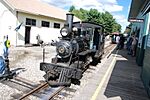 |
Steam | 0-4-4RT | Vulcan Iron Works | 1904 | Under restoration |
| 11 | Steam | 2-4-4RT | Wiscasset, Waterville and Farmington Railway | 2017–present | Under construction | |
| 51 | Track car | Unknown | Brookville | 1947 | Operational | |
| 52 | 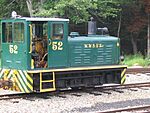 |
Diesel | DDT-6 12 ton-switcher | Plymouth Locomotive Works | 1962 | Operational |
| 53 | Diesel | 45-ton switcher | General Electric | 1941 | Stored, out of service |
Visiting Locomotives
Other museums and owners sometimes lend their locomotives to the WW&F Railway Museum.
| Number | Image | Type | Class | Builder | Built | Serial Number | Status | Owner | Notes |
|---|---|---|---|---|---|---|---|---|---|
| 3 |  |
Steam | 0-4-4RT | Vulcan Iron Works | 1912 | 2093 | Operational | Maine Narrow Gauge Railroad Museum | In service at Edaville |
| 4 | 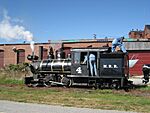 |
Steam | 0-4-4RT | Vulcan Iron Works | 1918 | 2780 | Dissassembled, awaiting overhaul | Maine Narrow Gauge Railroad Museum | |
| 7 | Steam | 2-4-4RT | Baldwin Locomotive Works | 1913 | 40864 | Operational | Maine Narrow Gauge Railroad Museum | In service at Maine Narrow Gauge | |
| 8 | 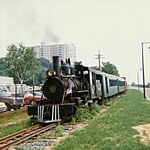 |
Steam | 2-4-4RT | Baldwin Locomotive Works | 1924 | 57659 | Stored, awaiting restoration | Maine Narrow Gauge Railroad Museum | |
| 11 | Steam | 0-4-0 | HK Porter | 1925 | 6976 | Operational | Maine Locomotive & Machine Works | On loan from Maine Locomotive & Machine Works |
Former Locomotives of the Original Railway
The original WW&F Railway used many different steam locomotives over its years of operation. Most of these were scrapped after the railway closed in 1933.
| Number | Image | Type | Class | Builder | Built | Works number | Notes |
|---|---|---|---|---|---|---|---|
| 1 | Steam | 0-4-4RT | HK Porter | 1883 | 565 | Scrapped in 1916 | |
| 2 | Steam | 0-4-4RT | Portland Company | 1894 | 626 | Scrapped in 1937 | |
| 3 | Steam | 0-4-4RT | Portland Company | 1894 | 627 | Scrapped in 1937 | |
| 4 |  |
Steam | 0-4-4RT | HK Porter | 1902 | 2497 | Scrapped in 1937 |
| 5 | Steam | 0-4-4RT | Hinkley Locomotive Works | 1882 | 1564 | Scrapped in 1912 | |
| 6 | Steam | 2-6-2 | Baldwin Locomotive Works | 1907 | 31691 | Scrapped in 1937 | |
| 7 | Steam | 2-4-4RT | Baldwin Locomotive Works | 1907 | 31692 | Scrapped in 1937 | |
| 8 | Steam | 0-4-4RT | Portland Company | 1892 | 624 | Scrapped in 1937 |
Rolling Stock (Train Cars)
The railway used many different types of cars. These included flatcars for carrying large items, boxcars for enclosed cargo, and passenger cars for people.
When the railway first started, it had flat cars, box cars, a caboose, and gondolas (open-top cars for coal). It also had a snowplow and a flanger (a tool to clear ice from the rails). Passenger cars included coaches, a baggage car, and a car for mail.
As the railway grew, more cars were added. Some boxcars were even made taller. The Wiscasset car shop also rebuilt many cars. For example, some flatcars became boxcars. Special boxcars were made with hinged doors and insulated walls to carry cream or potatoes, keeping them from freezing in winter.
See also
- List of heritage railroads in the United States


